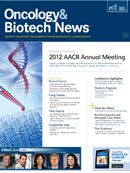Publication
Article
Oncology & Biotech News
Epigenetics Breathes New Life Into Older Cancer Drugs
Author(s):
Cancer drugs once deemed too toxic for humans have earned a second chance at therapeutic utility, in part because of a reversal in the usual progression of medical research.
Stephen Baylin, MD
Cancer drugs once deemed too toxic for humans have earned a second chance at therapeutic utility, in part because of a reversal in the usual progression of medical research.
The DNA demethylating agents decitabine and azacitidine have already earned a niche in the treatment of myelodysplastic syndrome (MDS) and acute myeloid leukemia (AML). The success, occurring at lower does than previously established as effective, led researchers to examine the drugs’ activity in epithelial tumor cells.
Laboratory studies showed that low doses of the demethylating agents trigger an antitumor “memory” response that includes inhibition of subpopulations of self-renewing cells resembling cancer stem cells. Other antitumor activities accompany the inhibitory effect, including decreased genomewide promoter DNA methylation, gene re-expression, and changes in key regulatory pathways.
“We believe low-dose decitabine and azacitidine could have broad applicability in the treatment of cancer,” explained Stephen Baylin, MD, deputy director of the Johns Hopkins Kimmel Cancer Center in Baltimore, Maryland, during a press briefing at the 2012 AACR Annual Meeting.
The drugs’ ability at nanomolar doses to target populations of stem-like self-renewing and tumorigenic cells has potentially major implications, he added. A major limitation of cancer therapy has been failure to target the cell populations most responsible for cancer cells’ sustained-renewal capability.
The findings were reported simultaneously in the journal Cancer Cell.
Typically, translational research begins with laboratory investigations that produce clinically relevant data, which are then applied in clinical studies. The opposite occurred with decitabine and azacitidine, as success in hematologic malignancies, followed by encouraging results in a small group of patients with advanced lung cancer, provided the impetus for a return trip to the laboratory.
Decitabine and azacitidine are members of a growing list of epigenetic drugs that can alter gene expression and other aspects of cell function without affecting the DNA. Originally developed as nucleoside analogs, the drugs clearly cause DNA damage at high doses. However, Baylin and colleagues speculated that the success in MDS and AML reflected other mechanisms that exert their effects only at low doses.
In a series of experiments, the investigators showed that low doses of decitabine and azacitidine inhibited cell growth and caused tumors to shrink in a xenograft model of breast cancer. Using cells from patients with metastatic breast cancer, Baylin and colleagues then demonstrated that 3 days of exposure to 500 nM of azacitidine effectively terminated the cells’ self-renewal properties.
Researchers also demonstrated that low doses of the DNA demethylating agents restored function to pathways that had been silenced during development. The effects include pathways involved in the cell cycle and in cell repair, maturation, differentiation, and programmed death. The low-dose exposure also inhibited signaling in certain pro-tumorigenic pathways.
The complex activity and effects, “may actually give decitabine and azacitidine an important advantage in treating cancer cells where they may target all of these functions and their role in governing the epigenetic aberrancies present in cancer,” Baylin and colleagues wrote in the journal article.
“If so, the activities we find for low nanomolar doses may be very important in rendering these drugs as gold standards for the development of agents to target DNA methylation and other epigenetic abnormalities as an anticancer strategy to inhibit the most tumorigenic subpopulations of cells.”
Tsai HC, Li H, Van Neste L, et al. Transient low doses of DNA-demethylating agents exert durable antitumor effects on hematological and epithelial tumor cells. Cancer Cell. 2012;21(3):430-446.







%20(2)%201-Recovered-Recovered-Recovered-Recovered-Recovered.jpg?fit=crop&auto=format)

%20(2)%201-Recovered-Recovered-Recovered-Recovered-Recovered.jpg?fit=crop&auto=format)
%20(2)%201-Recovered-Recovered-Recovered-Recovered-Recovered.jpg?fit=crop&auto=format)